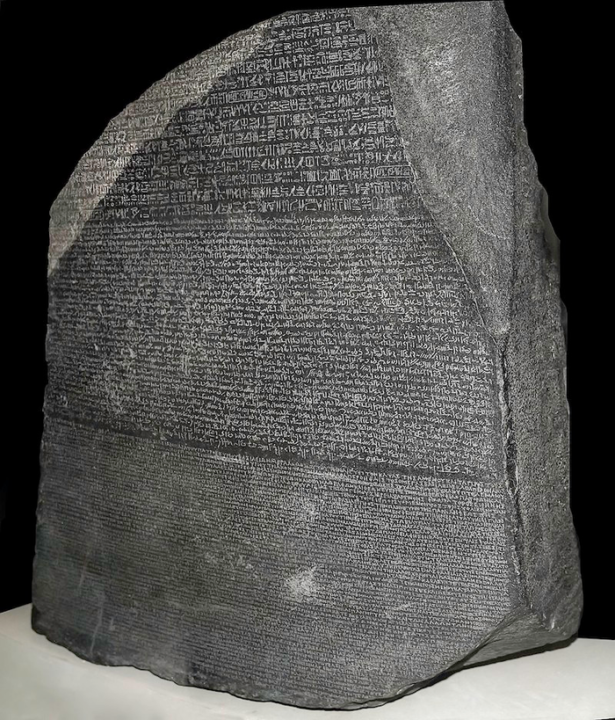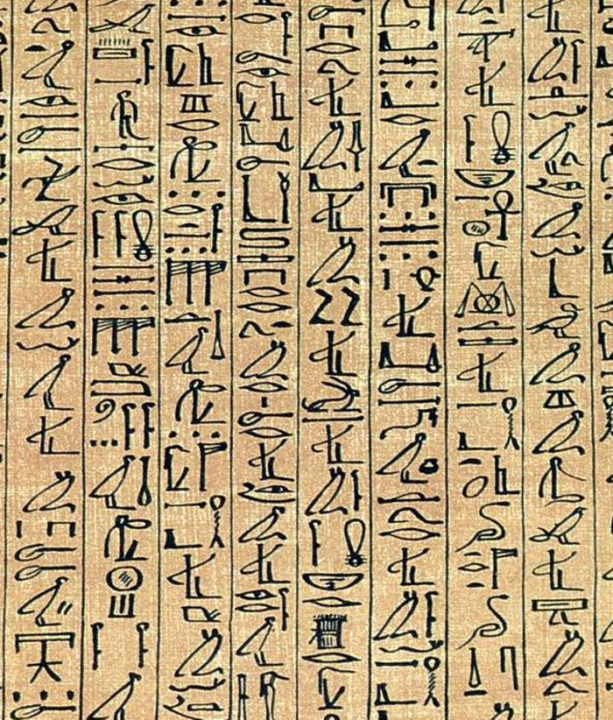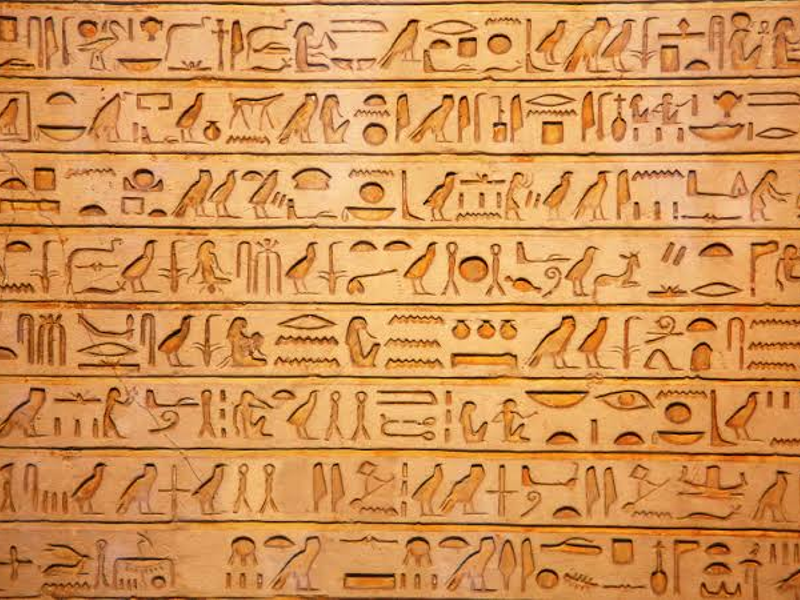Image: Egyptian Heiroglyphics. Source: Wikimedia Commons
One of the most intriguing discoveries from ancient Egyptian civilization is the hieroglyphic writing that appears like stylized pictures of people, animals, and objects. Derived from hieroglyphikos, the Greek word for “sacred carving,” this ancient writing has fascinated archaeologists, historians, and linguists for centuries. Found carved on the insides of ancient Egyptian temples, monuments, and tombs, it represents a complex remnant of history, offering a unique glimpse into the rich and complicated world of ancient Egypt.
Just because the symbols used in hieroglyphic writing look like little pictures of people, animals, and objects, it does not mean they represent those things. Instead, some hieroglyphs signify sounds in the ancient Egyptian language, just as the characters in the Roman alphabet do. Others are ideographic signs, which represent concepts but don’t have a sound attached.
There are three main kinds of hieroglyphic symbols.
- Logograms, representing words,
- Phonograms, representing sounds
- Determinatives, placed at the end of the word to specify things such as number, gender, and tense and help clarify its meaning.
Ancient Egyptians used these symbols to record their beliefs, stories, and daily life. Each symbol had its unique meaning, and together, they formed a visual language that withstood the test of time. Hieroglyphic symbols have endured centuries, permitting us to look into the past.
Prepare to be captivated by the wonders of ancient Egypt’s hieroglyphic writing system, as we explore the secrets of these timeless symbols that are only now seeing the light of day.
History of Egyptian Hieroglyphics
One of the most fascinating stories in the world is the history of ancient Egyptian hieroglyphics. Like most ancient scripts, the origin is poorly understood as it is not known exactly where and when Egyptian writing first began. However, several hypotheses have been put forth. One of the most convincing views claims that they derive from rock pictures produced by prehistoric hunting communities living in the desert west of the Nile.
It was already well-advanced two centuries before the start of the First Dynasty which suggests a date for its invention in Egypt around 3,000 B.C.E. It was used continuously over 3,500 years. The earliest surviving examples are bone labels inscribed with symbols, which were found in a tomb at Abydos and dated to c3150 BC. The last-known inscription was carved on the temple of Philae on 24 August AD 394. For quite a long time, the pictographs stayed a secret to researchers and travelers. Scientists and archeologists had little success in the interpretation of ancient Egyptian hieroglyphs.
Discovery of the Rosetta Stone and How It Paved the Way for the Modern Understanding of Ancient Egyptian Writing

The Rosetta Stone. Source: Wikimedia Commons
However, there was a turning point in 1799. French soldiers serving under Napoleon in Egypt were repairing a fort in the town of Rashid (also known as Rosetta) when they discovered a stone slab. This became known as the Rosetta Stone which unlocked the secrets of a once-lost language, shedding light on the enigmatic civilization that created it. The stone was covered with writing in three different scripts -hieroglyphic writing, demotic, and ancient Greek. This revelation enabled researchers to decipher the symbolic representations, whose mystery remained uncracked for centuries. Deciphering the hieroglyphs paved the way for understanding Egyptian history, religion, culture, and administration.
The Rosetta Stone’s discovery captured the imagination of linguists and scholars. Etymologists and researchers committed themselves to unraveling the hieroglyphic content. In 1822, Jean-François Champollion became the first person to decipher their texts for over a thousand years. By comparing the three scripts, the young French scholar astutely recognized that the hieroglyphs represented both phonetic sounds and ideographic symbols. His groundbreaking work enabled scholars to read and understand ancient Egyptian texts for the first time in over a millennium.
Acting as a linguistic bridge, the Rosetta Stone unveiled the cultural, religious, and historical aspects of ancient Egyptian society. It also offered invaluable insights into the lives of pharaohs, the construction of pyramids, and the worship of gods. Today, the Rosetta Stone resides in the British Museum in London.
The Spiritual Significance of Hieroglyphs

Heiroglyphs written on papyrus from The Book of the Dead. Source: Wikimedia Commons
The ancient Egyptians believed that hieroglyphics had magical powers. It was seen as a sacred language, a divine script believed to be a gift from the gods. They had a strong belief that writing something down would make it happen in real life. Each symbol carried the weight of spiritual significance.
Religion played a key role in ancient Egyptian society, and hieroglyphics were intimately connected to religious beliefs and practices. Hieroglyphics were used to convey sacred texts, prayers, hymns, magical spells, and rituals in temples and tombs. They were believed to carry a sacred power, providing a direct link between the mortal world and the divine realms, and were used to invoke and communicate with the gods.
Hieroglyphic inscriptions on temple walls also detailed the myths, legends, and religious ceremonies of the ancient Egyptians.
In funerary contexts, many ancient Egyptians had hieroglyphic guides of the afterworld written on the surfaces of tomb walls and the insides of coffins. This was to guide the deceased through the perilous journey in the underworld and ensure a successful journey to the afterlife. The Book of the Dead, a collection of spells and prayers, was often buried with the deceased to aid them in their journey.
Challenges of deciphering hieroglyphics
Figuring out the meaning of texts written in hieroglyphic writing remains a big challenge for scholars. It requires a certain amount of subjective interpretation and a comprehensive understanding of the script’s various components and their interplay as the symbols are not straightforward alphabets. They could represent sounds, concepts, or entire words. Even reading them aloud is not easy.
Hieroglyphs are difficult to read for several reasons;
- They are a highly stylized form of writing that often depicts objects and concepts rather than phonetic sounds.
- Symbols can have multiple meanings. It can be alphabetical, bilateral, trilateral, or determinative depending on the context in which they are used.
- There is no punctuation and no spaces between words.
- Many hieroglyphs are highly symbolic, meaning that they represent abstract concepts rather than concrete objects.
- Finally, the hieroglyphic script was used for over 3,000 years, during which time the language and writing system underwent significant changes, making it difficult to decipher and understand the meaning of some of the symbols.





